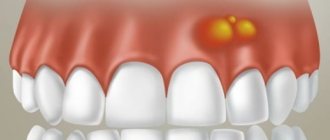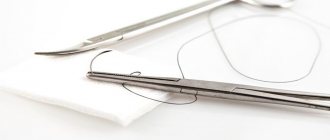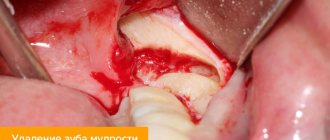16.11.2019
Such a complication as stomatitis after tooth extraction is well known in dental practice. Moreover, the source of inflammation can appear not only on the gum, where the tooth used to be, but also on other places on the mucous surface of the oral cavity. The cause of the disease may be the unscrupulous work of the dentist. The patient himself can influence the formation of ulcerative defects. In any case, it is necessary to carry out full treatment of the disease.
The connection between surgery and stomatitis
It would seem, what could be the connection between tooth extraction surgery and stomatitis - inflammation of the oral mucosa? The most direct one. Dentistry, which studies dental, jaw and other diseases of the oral cavity, has proven that all processes in the mouth are interconnected.
Accordingly, tooth extraction is quite capable of causing symptoms of stomatitis: painful ulcers, erosion, a specific white coating that hides bleeding wounds, and an unpleasant odor. Most often, defects appear on the gums or close to them: on the inside of the lips, palate, and floor of the mouth. The inner area of the cheek can also become inflamed if the disease occurs after the removal of a wisdom tooth. Without timely treatment, ulcers begin to spread throughout the mouth.
Of course, not every tooth extraction entails inflammation of certain areas of the oral mucosa. This requires additional conditions.
Is stomatitis contagious?
Whether stomatitis is transmitted or not is a question that worries many. Ulcers are not contagious if they are the result of:
– mechanical injuries;
– allergies;
- during intoxication.
If the cause of stomatitis is an infection, then the disease can spread to other people. These types include fungal, herpetic, and infectious stomatitis.
When the patient is to blame
Stomatitis can occur even if the dentist has followed safety precautions and completely removed the tooth. Sometimes the patient himself is to blame. This can happen due to neglect of postoperative care for the affected tooth socket. After pulling out a tooth, you should not pick at the wound with foreign objects or rinse your mouth vigorously. Otherwise, a blood clot will fall out of the tooth socket - protection against pathogens.
Stomatitis after tooth extraction can occur due to ignoring the rules of personal hygiene: poor oral care, eating unwashed foods, eating with dirty hands.
Complex wisdom tooth removal
During such an operation, the surgeon uses many more instruments and performs more complex manipulations, in particular, cutting soft tissues and suturing the incision without fail.
Complex removal is carried out if:
- we are talking about removing the lower wisdom tooth;
- there is an abnormal root system;
- the coronal part is severely destroyed;
- impacted, dystopic molars.
Preparation for the operation follows approximately the same pattern as for simple wisdom tooth removal, but this is where the similarities end. This is noticeable already at the initial stage: more time is allocated for the effects of anesthesia - about 10 minutes.
Other circumstances
Other circumstances may also influence the development of stomatitis after tooth extraction. For example, a patient has an allergic reaction to local or general anesthesia. In this case, an allergic form of the disease manifests itself.
Sometimes, after a tooth is pulled out, a blood clot does not appear in the tooth socket. Pathogenic microorganisms begin to penetrate into the tissue of the unprotected hole, causing inflammation.
Kissing an infected person can also lead to stomatitis at the site of an extracted tooth. Or using dirty common items in a cafe, canteen, or home.
There is a high probability of the disease occurring if the patient has a weak immune system, and there are several wounds and they take a long time to heal. Most often this happens after the removal of a wisdom tooth. Due to its inaccessibility, the dentist sometimes has to cut the gum and part of the cheek before surgery.
Features of the structure of wisdom teeth
The structure of a wisdom tooth is no different from other molars and consists of a neck, a root system (4–5 pieces) and a crown. In some cases, root development is disrupted and a single conglomerate is formed, that is, a tooth grows with one root.
Its only difference from its neighbors is that recent studies recognize the wisdom tooth as a rudiment that has lost its functional purpose during the evolutionary development of man. Scientists do not consider it as a full-fledged organ, since some part of humanity does not grow it at all.
However, the wisdom tooth has several parameters that distinguish it from the same “seven”:
- lack of milk precursors, which ultimately complicates eruption and impedes growth. There is no room left for it on the dental arch, which is why various developmental pathologies arise;
- the number of roots is greater than that of other molars - up to 5 pieces. In this regard, problems often arise when removing a wisdom tooth;
- significantly curved roots of the “eights” make cleaning and treatment of root canals very difficult;
- poor blood supply compared to other teeth leads to rapid aging, accompanied by fragility and susceptibility of tissues to caries, despite minimal load;
- many pathological conditions, for example, pathologies of the masticatory muscles, malocclusion, pericoronitis, are associated with the growth of “eights”.
Thus, the appearance of third molars has many more negative consequences than positive ones. Many patients are forced to see a dentist even before they can be seen in person.
The consequences are dangerous
Without timely treatment, seemingly harmless stomatitis can bring many negative consequences. Pathogenic microorganisms begin to secrete toxins - poison of biological origin.
Once in the blood or stomach, toxins poison the body. Intoxication leads to deterioration of health. Headaches and joint pains appear, appetite disappears, lethargy, nausea are felt, diarrhea begins, and the temperature may rise.
Other pathologies may develop: from inflammation of the throat or respiratory tract to destruction of the jaw bone or general infection of the circulatory system.
Comprehensive treatment of stomatitis will help to avoid complications. But before you begin self-therapy, you need to contact your dentist again. Or visit a therapist for adults, or a pediatrician for children. Only a doctor can determine the type of disease and prescribe appropriate medications.
Treatment of stomatitis
The method of treating the disease depends on the type of stomatitis, which the doctor can determine. That is why, if ulcers appear in the mouth, you should immediately consult a doctor. He will tell you whether this form of stomatitis is contagious or not.
To reduce pain, various ointments can be used, for example, "Cholisal". This is one of the most effective remedies for treating gums with stomatitis. The medicine restores the oral mucosa, relieves inflammation and pain. Lidocaine, Kamistad, and Anestezin have similar properties.
To reduce microbes in the mouth, you can use chlorhexidine, furatsilin. To treat microbial stomatitis, you will need antibiotics, for example, such as: “Agumentin”, “Amoxicillin”, “Lincomecin”, etc. During the treatment of stomatitis, you can also use various mouth rinses and balms with extracts of chamomile, calendula, and eucalyptus.
Remember that the article is advisory in nature, so in order to avoid complications you should not self-medicate. It is better to consult a specialist for effective and quick treatment of stomatitis.
Professional care and disinfection
Treatment of stomatitis that occurs after tooth extraction begins with the elimination of concomitant diseases in the oral cavity and professional teeth cleaning. Then it is necessary to disinfect the surface of the mucous membrane using antiseptics:
- soda solution;
- brilliant greens;
- hydrogen peroxide;
- potassium permanganate solution;
- "Chlorhexidine";
- "Miramistina";
- "Furacilina".
This will minimize the number of pathogenic microorganisms, which will speed up recovery. Before treating stomatitis with any medication, you must obtain permission from your doctor.
How to treat stomatitis
Whatever the form of stomatitis, treatment always begins with a visit to the dentist.
He makes a diagnosis and prescribes treatment. If necessary, you may need to consult other specialists, such as a gastroenterologist, immunologist or allergist. Depending on the form of stomatitis, the doctor examines the patient and listens to complaints or prescribes laboratory tests, for example, bacterial culture of a smear or skin scraping, as well as a PCR study to determine the causative agent (herpes virus, fungus, etc.). Treatment of stomatitis usually occurs with local remedies and includes:
- normalization and maintenance of high-quality oral hygiene
- spot treatment of ulcers with drugs with antimicrobial, antiviral or antifungal action
- pain relief with anesthetics
- reducing swelling and redness with anti-inflammatory drugs
In addition, part of the therapy is a special diet that will help reduce inflammation and will not irritate the mucous membrane.
Vitamins are the key to health
At the same time as using disinfectants, it is necessary to strengthen the immune system. This can be done with a diet rich in vitamins, macro and microelements. On the recommendation of a specialist, you can take a vitamin and mineral complex: “Alphabet”, Vitrum, “Multi Tabs”, “Centrum”.
Decoctions or extracts of echinacea, eleutherococcus, ginseng, and Schisandra chinensis will help. If necessary, the doctor prescribes drugs to enhance immunity: “Ribomunil”, “Imudon”, “Irs-19”, “Likopid”, “Derinat”, “Timaktide”.
If stomatitis occurs due to problems with the gastrointestinal tract, complex treatment should include drugs containing beneficial microorganisms - probiotics. They will help restore the microflora of the digestive tract. These include “Bifidumbacterin”, “Lactobacterin”, “Acilact”, “Bifilong”, “Narine”.
To speed up the healing of damaged mucosal surfaces, sea buckthorn or rosehip oil, vinylin, and propolis preparations are prescribed.
Indications for wisdom tooth removal
Treating third molars is a challenging task, but a competent dentist will try to keep the unit relatively healthy. However, in practice, even relatively healthy “eights” are extremely rare.
Most often, problems begin at the teething stage, which is associated with pain, fever, swelling and other troubles. The doctor prescribes wisdom tooth removal if:
- an unerupted molar is incorrectly positioned in the jaw, injuring neighboring teeth and soft tissues;
- extensive caries damage with significant destruction of the crown;
- pericoronitis (presence of an inflamed hood);
- installation of a bracket system. Sometimes only the removal of a wisdom tooth can ensure the correct movement of other molars;
- presence of a cyst;
- the trigeminal nerve is pinched;
- pulpitis, periodontitis.
Most experts are inclined to believe that the “eight” should be under the supervision of a doctor from the moment of eruption. An x-ray is sufficient to assess the development of the tooth and assess future prospects. This needs to be done immediately, if only because for young people the rehabilitation period is much easier and the likelihood of complications is minimal.
Stages of complex wisdom tooth removal
The methodology may differ for each specific case, but in general terms several approximate stages can be outlined:
- 1. local anesthesia;
- 2. incision of soft tissues, peeling them off the bone;
- 3. sawing, drilling out the proper bone tissue;
- 4. extracting the “eight”;
- 5. treatment of a fresh hole left after the removal of a diseased wisdom tooth;
- 6. suturing with non-absorbable suture material;
- 7. The doctor will remove the stitches only after the edges of the wound have completely fused.
The duration of the procedure depends on the situation and can last from 30 minutes to 2 hours. After the operation, the doctor advises the patient regarding wound care, prescribes medications and informs the date of the next appointment.
What may bother you after tooth extraction?
Unfortunately, not everyone can boast of healthy teeth. Rare visits to the dentist, poor environment, smoking, caries and tooth decay are not the entire list of reasons that contribute to tooth loss. The procedure for tooth extraction may be absolutely painless, but the consequences afterwards are much more serious.
Why does pain occur after tooth extraction?
Pain can be a completely normal reaction of the body. During the tooth extraction process, anesthesia is applied and the patient feels comfortable. A few hours later the pain begins and the patient tries not to notice it - after all, there was an intervention in the body. The pain may be aching, but, as a rule, it practically does not interfere with our lifestyle, and soon it goes away altogether.
Unpleasant sensations after tooth extraction may continue for the next 24 hours. It is worth considering when the pain does not go away for more than two or three days and you are bothered by a headache. Pay attention to the gum and cheek: if there is swelling and swelling, then most likely your dentist did not completely remove the cyst or tooth root. In this case, you should consult a specialist again, or consult a more professional doctor.
Another cause of pain is alveolitis or acute inflammation of the walls of the socket at the site of the extracted tooth. Alveolitis occurs with complex tooth extraction, that is, when the tooth is partially removed. The diagnosis is also possible due to disturbances in the formation of a blood clot closing the wound. A clot is a biological barrier that should protect the socket from infection; if the clot does not appear at all or is dislodged, an infection enters the wound and alveolitis occurs.
With this diagnosis, in addition to a possible headache, there may be a fever, throbbing or acute pain in the socket, eating is almost impossible, sensitivity to cold and hot food or drinks increases, a bitter taste and foul odor appear in the mouth, salivation increases, and the body feels weak. .
Remember that alveolitis occurs due to the fault of the patient himself. Firstly, with active rinsing of the mouth: the wounded surface “opens up”, the blood clot is washed out and infection occurs. Secondly, alveolitis can be caused by poor oral hygiene: when food gets into the socket or caries of neighboring teeth.
Another cause of pain after tooth extraction is trigeminal neuritis. This diagnosis is possible when a tooth is removed from the lower row. In this case, the pain will be “shooting” and disturbs the patient not only in the oral cavity, but radiates to the temples, eyes and neck, while there is no swelling of the gums or cheeks.. Trigeminal neuritis, compared to alveolitis, is not dangerous at all and will go away after a few hours .
What to do if pain occurs after tooth extraction and signs indicate alveolitis?
Do not self-medicate under any circumstances! As it became known, there are many causes of pain, and the diagnoses are disappointing. The pain will not go away on its own! Painkillers will only help you for a while, but one hundred percent the pain will return.
In all of the above cases, only a dentist can help you.
If a tooth root or part of a tooth remains, then no pills will help you - only repeated removal. With alveolitis, it is generally dangerous to delay time - this is fraught with more serious complications. If the socket is damaged, then the dentist’s main task is to form a new blood clot. This is only possible in a dental clinic! Remember that by providing timely assistance, you will not only alleviate your suffering, but also save money - the duration and price of therapy will differ significantly from “neglected” cases. Take care of your health! come back
Ulcerative stomatitis - symptoms and treatment
The main goal of therapy is to reduce pain and speed up healing. First of all, it is necessary to eliminate irritants that cause discomfort to the patient. The next step is to reduce symptoms as much as possible.
To treat stomatitis, rinsing with solutions of furatsilin, miramistin, chlorhexidine, and hydrogen peroxide is prescribed. Rinsing will reduce pain and itching, and cleanse the oral cavity of food debris that injures the damaged areas.
In case of severe pain, applications with painkillers are prescribed - “Kamistad”, “Lidocaine Asept”. Treatment for different forms of stomatitis will differ.
Infectious stomatitis. When treating, it is first necessary to understand what problem with the immune system caused this condition and to strengthen the body’s defenses. To do this, Prodigiosan is administered intramuscularly, the oral cavity is treated with antiseptics, proteolytic enzymes, and UV therapy is prescribed [11].
Vesicular stomatitis. To reduce symptoms, proper rest, drinking plenty of fluids, and taking antipyretic medications will be helpful. Also, the oral mucosa is treated with antiseptics (Suprastin, Hexetidine, Pipolfen) and antiviral ointments are used - rhiodoxol and tebrofen. Antiherpetic drugs are often prescribed - Famciclovir, Acyclovir, Valacyclovir. If you follow the doctor’s recommendations, the symptoms of the disease quickly go away and the patient recovers.
Vincent's ulcerative necrotic stomatitis. During treatment, dental plaque is carefully removed, the oral mucosa is treated with antiseptics, and multivitamins are prescribed (for example, Complivita).
Allergic stomatitis. Treatment consists of eliminating the cause of the allergy and taking oral antihistamines. In severe cases of allergic stomatitis, sodium thiosulfate solution is administered intravenously. During treatment in a hospital, drip infusions of hemodez, isotonic sodium chloride solution, polyglucin, and corticosteroids are prescribed.
Chronic recurrent aphthous stomatitis. With local treatment, traumatic factors are eliminated, the mouth is rinsed with tetracycline (250 mg per 5 ml of water 4 times a day for 5-7 days), applications are made with corticosteroids and antibiotics, and painkillers are prescribed. For deep ulcers, proteolytic enzymes are used.
General treatment includes taking medications:
- tetracycline, rifampicin (two capsules twice a day);
- “Tarivid” (one tablet twice a day for 20 days);
- sodium thiosulfate (10 ml of 30% solution intravenously once a day or 1.5-3 g orally);
- “Prodigiosan” (start with 15 mcg once every five days and increase the dose to 100 mcg);
- "Levamisole" (50 mg three times a day two days in a row a week or 150 mg once);
- "Delagil" (one tablet once a day);
- "Colchicine" (one tablet twice a day for two months);
- "Aevit" (1 ml once a day intramuscularly for 20 days);
- “Histaglobulin” (2 ml subcutaneously once every three days) [11].
Stomatitis due to intoxication with salts of heavy metals and chemical solutions. If a chemical gets on the mucous membrane, you must immediately wash it off with a neutralizing solution. Further treatment of patients with chemical burns is carried out with painkillers and antiseptics and drugs that accelerate the restoration of the epithelium. A high-calorie diet is also important. For extensive scars, surgical intervention is indicated [15].











